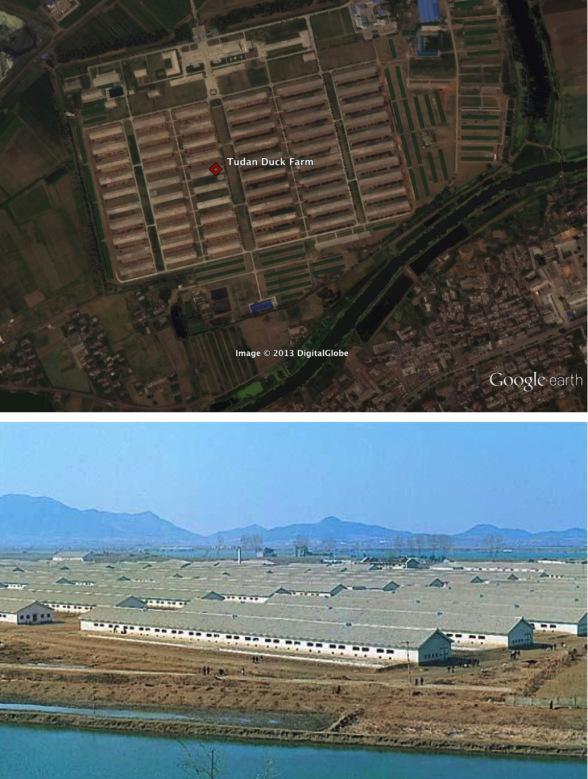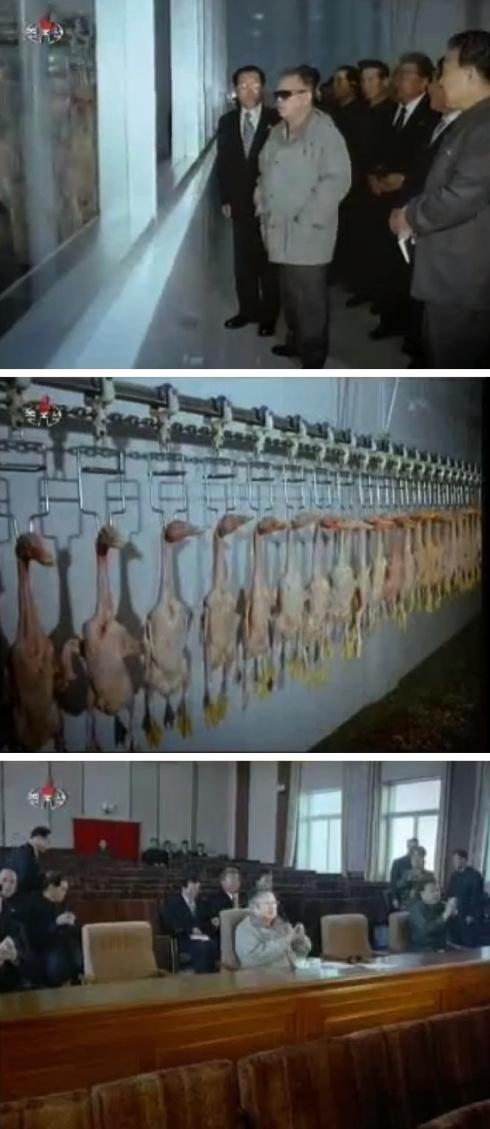
The Pyongyang Tudan Duck Farm in east Pyongyang, where an outbreak of avian flu was discovered in mid-April 2013 (Photos: Google image and KCNA/FLPH file photo)
An outbreak of a new strain of avian influenza (H5N1) has been found in the DPRK. On 19 April 2013, the outbreak was discovered in one cage of ducks at the Pyongyang Tudan Duck Farm who exhibited symptoms of avian flu. After the initial cage of infected ducks began to die, cages of ducks were tested by the Central Veterinary Station (a national laboratory subordinated to the State Academy of Sciences) on 2 May 2013 and revealed that 20 cages of ducks were infected with avian flu. Approximately 164,000 ducks died from avian flu or were killed. The outbreak of avian flue at the Tudan Duck Farm was later corroborated by a second round of tests conducted by the Veterinary Institute of the Academy of Agricultural Sciences (subordinate to the Ministry of Agriculture). On 13 May 2013 the DPRK Ministry of Agriculture’s Anti-Epizootic Department submitted a formal notification of the avian flu outbreak to the World Organization for Animal Health. Since the initial outbreak, DPRK authorities moved to quarantine and cull infected animals, control the shipment of livestock inside the country and test other animals for the disease. The outbreak of H5N1 has been speculatively linked to the ducks’ contact with wild birds or animals. The summary of the DPRK’s report to the World Organization for Animal Health can be read here [PDF].
On 14 May 2013, KCNA interviewed two DPRK officials, Pak Myong Su from the Ministry of Public Health and Jon Song Hun from the Korea Pugang Pharmaceutical Company, on the development of a drug called Kumdang-2 which was touted an effective vaccination against human cases of avian flu. According to the interview:
Question: Please tell me about danger of virus H7N9 and measures for prevention of infection.
Pak: The virus had been known to be low in toxicity with the cause and way of its infection uncertain, but later it was confirmed through gene analysis that it has a highly infectious toxicity.
With an increasing number of people infected or dead by this virus, the World Health Organization (WHO) has called for taking strict measures against the spread of the virus.
What is most important for people is to enhance their immunity, while taking anti-epidemic measures.
Patients, infected with epidemics including the bird flu, are all weak in immunity. Therefore, it is advisable to take medicines helpful to enhancing immunity.
Q: I know that Kumdang-2 Injection, manufactured by the Korea Pugang Pharmaceutic Co., Ltd., has been considered worldwide to be one of highly effective adjuvants.
Jon: As early as in 2003, WHO warned that various strains of epidemic flu viruses would sweep throughout the world and inflict enormous damages on mankind, while calling for development of medicines to prevent infection of all strains of influenza viruses.
After many years of research and clinical trials, the Korea Pugang Pharmaceutic Co., Ltd. made Kumdang-2 Injection composed of the compounds of insam saccharides plus REE (rare earth elements) as main component and micro quantities of gold and platinum.
Kumdang-2 Injection, once injected into a living body, stimulates hypothalamus, the human body’s supreme nerve system, thereby optimizing its immune system as a whole, and boosts over 16 times the capacity of generating the interferon, the anti-virus effects whereof are so strong and wide that it can oppress the severe new flu virus, too.
Kumdang-2 Injection has enjoyed great popularity for its wonderful effects and many countries widely use it as not only immune activators but high-quality medicine, much more efficacious than antibiotics.
According to the clinical records, three rounds of its injection in every five minutes kill influenza virus H1N1.
On 18 May 2013, Rodong Sinmun published a fairly detailed account about what the central authorities were doing to deal with the outbreak of avian flu. After the discovery of the outbreak in April, according to Rodong, Kim Jong Un (Kim Cho’ng-u’n) “gave precious instruction on establishing thorough measures to ensure that bird flu does not come into our country, emergency anti-epidemic committees that include senior functionaries in relevant sectors were organized in every province, city (district), and county.” Rodong also reported that “functionaries of the National Emergency Anti-Epidemic Commission are highly upholding the noble intent of the respected and beloved marshal, who always gives great attention to promoting the people’s health, and meticulously planning and coordinating organization work to ensure that patients with the new type of bird flu do not occur.” The regional and local anti-epidemic committees “go deep among the masses and inform them in a mobile manner of issues that arise in pro-actively conducting this work, they are putting great effort into actively utilizing a variety of means to ensure the normalization of hygiene propaganda and examination work.”

Late DPRK supreme leader Kim Jong Il visits the Tudan Duck Farm in October 2011 (Photos: KCTV screengrabs)
Authorities of the Ministry of Public Health “sent explanatory and dialog lecture materials on preventing the new type of bird flu to various places nationwide in a short time, and they are actively establishing measures to conduct hygiene propaganda and examination work at a high level for people on site.” During late April, according to Rodong, “Ministry of Public Health functionaries and approximately 1,000 medical functionaries from various treatment and prevention organs, beginning with the Pyongyang University of Medicine at Kim Il Sung University, performed hygiene propaganda activities for well over 40,000 households in the capital, and hundreds of medical functionaries did so for citizens at dozens of spots along major bus routes.” From late April to mid-May Rodong reported that “many youths, students, and medical functionaries went out to people’s houses, coal mines, and farm villages and carried out hygiene propaganda for approximately 300,000 workers, and thousands of medical functionaries conducted examinations and checkups for nearly 500,000 people” and that “hygiene propaganda activities by social hygiene propaganda forces and propaganda vehicles such as the Youth League Central Committee and Education Committee are being actively conducted through various formats and methods.” The informational campaign “activities are being carried out nationwide for an average of millions of workers at every level each day, and employees working at farms everywhere are receiving examinations and checkups by medical functionaries running clinics.”
The Ministry of Public Health and other central authorities were also taking practical measures to contain the avian flu outbreak. Rodong Sinmun reported that “work to establish hygienic and cultural living environments and working conditions is being launched more vigorously than at any time before at various places nationwide, and medical functionaries at the Central Hygienic and Anti-Epidemic Station and provincial, city (district), and county hygiene and anti-epidemic stations are going down to their areas of responsibility and actively carrying out preventive work” and that “under the state’s unitary guidance, emergency anti-epidemic measures that can immediately eradicate bird flu if it appears in their particular area are thoroughly established now at every province, city (district), and county.” Rodong also reported that “party members and workers everywhere are embracing a burning enthusiasm to display the superiority of our country’s socialist public health system that makes prevention its basis under the wise leadership of the respected and beloved marshal, and they are continuing to vigorously wage the struggle to prevent damage from bird flu in advance.”
Filed under: 2013 Avian Flu Outbreak (Tudan), Administration Department, Central Broadcasting Committee, Central Committee, Civil Defense Department, cooperative farming, critical infrastructure, DPRK Cabinet, DPRK External Relations, DPRK Premier, food production, internal security, Kim Il Sung Youth League, Kim Jong-il, Kim Jong-un, Korean People's Internal Security Forces, Korean Workers' Party (KWP), kpif, land and enviroment, Light Industry Department, local people's committees, Ministry of Agriculture, Ministry of Food and Procurement, ministry of people's security, Ministry of Public Health, National Defense Commission (NDC), North Korean press, Organization and Guidance Department, population control, Propaganda and Agitation Department, Provinicial People's Committee, Publication Guidance Bureau, rural management committees, State Academy of Sciences, uawk, Working Organizations
